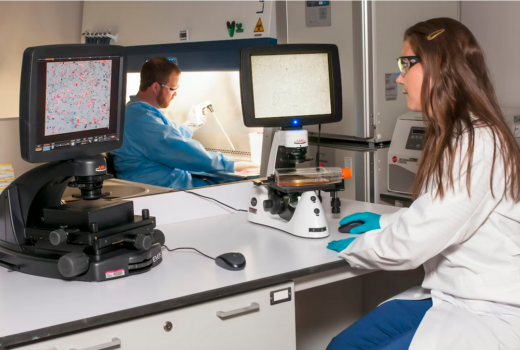Tijd-ruimte kromming bewezen
In december verwachten hij en zijn onderzoekers de complete data gereed te hebben.“We anticipate that it will take about eight more months of detailed data analysis to realize the full accuracy of the instrument and to reduce the measurement uncertainty from the 0.1 to 0.05 arc-seconds per year that we’ve achieved to date down to the expected final accuracy of better than 0.005 arc-seconds per year,” aldus William Bencze, de GP-B programma manager. “Understanding the details of this science data is a bit like an archeological dig. A scientist starts with a bulldozer, follows with a shovel, and then finally uses dental picks and toothbrushes to clear the dust away from the treasure. We are passing out the toothbrushes now.”
Two important discoveries were made while analyzing the gyroscope data from the spacecraft: one, the “polhode” motion of the gyroscopes dampens over time; two, the spin axes of the gyroscopes were affected by small classical torques. Both of these discoveries are symptoms of a single underlying cause: electrostatic patches on the surface of the rotor and housing. Patch effects in metal surfaces are well known in physics and were carefully studied by the GP-B team during the design of the experiment to limit their effects. Though previously understood to be microscopic surface phenomena that would average to zero, the GP-B rotors show patches of sufficient size to measurably affect the gyroscopes’ spins.
The gyroscope’s polhode motion is akin to the common “wobble” seen on a poorly thrown American football, though it shows up in a much different form for the ultra-spherical GP-B gyroscopes. While it was expected that this wobble would exhibit a constant pattern over the mission, it was found to slowly change due to minute energy dissipation from interactions of the rotor and housing electrostatic patches. The polhode wobble complicates the measurement of the relativity effects by putting a time-varying wobble signal into the data.
The electrostatic patches also cause small torques on the gyroscopes, particularly when the space vehicle axis of symmetry is not aligned with the gyroscope spin axes. Torques cause the spin axes of the gyroscopes to change orientation, and in certain circumstances, this effect can look like the relativity signal GP-B measures. Fortunately, the drifts due to these torques have a precise geometrical relationship to the misalignment of the gyro spin/vehicle symmetry axis and can be removed from the data without directly affecting the relativity measurement.
Both of these discoveries first had to be investigated, precisely modeled and carefully checked against the experimental data before they could be removed as sources of error. These additional investigations have added more than a year to the data analysis, and this work is still in process. To date, the team has made very good progress in this regard, according to its independent Science Advisory Committee, chaired by relativistic physicist Clifford Will of Washington University in St. Louis, Mo., that has been monitoring every aspect of GP-B for the past decade.
In addition to providing a first peek at the experimental results at the APS meeting, the GP-B team has released an archive of the raw experimental data. The data will be available through the National Space Sciences Data Center at the NASA Goddard Space Flight Center beginning in June.
Conceived by Stanford Professors Leonard Schiff, William Fairbank and Robert Cannon in 1959 and funded by NASA in 1964, GP-B is the longest running, continuous physics research program at both Stanford and NASA. While the experiment is simple in concept—it utilizes a star, a telescope and a spinning sphere—it took more than four decades and $760 million to design and produce all the cutting-edge technologies necessary to bring the GP-B satellite to the launch pad, carry out this “simple” experiment and analyze the data. On April 20, 2004, GP-B made history with a perfect launch from Vandenberg Air Force Base in California. After a four-month initialization and on-orbit check-out period, during which the four gyroscopes were spun up to an average of 4,000 rpm and the spacecraft and gyro spin axes were aligned with the guide star, IM Pegasi, the experiment commenced.
For 50 weeks, from August 2004 to August 2005, the spacecraft transmitted more than a terabyte of experimental data to the GP-B Mission Operations Center at Stanford. One of the most sophisticated satellites ever launched, the GP-B spacecraft performed magnificently throughout this period, as did the GP-B Mission Operations team, comprised of scientists and engineers from Stanford, NASA and Lockheed Martin, said Stanford Professor Emeritus Bradford Parkinson, a co-principal investigator with John Turneaure and Daniel DeBra, also emeritus professors at Stanford. The data collection ended on Sept. 29, 2005, when the helium in spacecraft’s dewar was finally exhausted. At that time, the GP-B team transitioned from mission operations to data analysis.
Meest Gelezen
Vrouwen houden universiteit draaiende, maar krijgen daarvoor geen waardering
Wederom intimidatie van journalisten door universiteit, nu in Delft
‘Burgerschapsonderwijs moet ook verplicht worden in hbo en wo’
Raad van State: laat taaltoets nog niet gelden voor hbo-opleidingen
Hbo-docent wil wel rolmodel zijn, maar niet eigen moreel kompas opdringen



